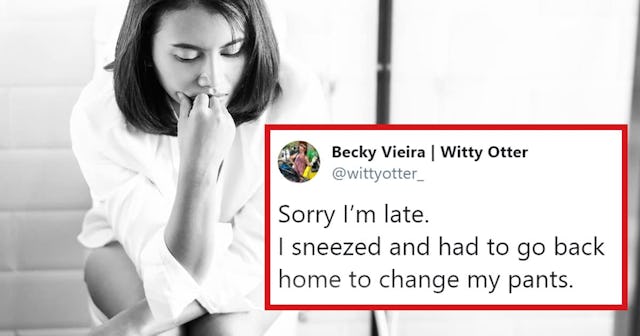Can We Stop It With The Mommy Bladder Jokes?

You’ve probably seen the memes and tweets about the infamous “mommy bladder” so many of us acquire after we’ve had a kid or two. You’ve probably laughed along with them, feeling a sense of relief knowing that you’re not the only one who leaks a little when you sneeze, jump, run, or cough–that you’re not the only one who’s had to change undies after a particularly good laugh-fest.
I’ve definitely laughed along with them, too. There’s nothing wrong with that. Finding humor in the uncomfortable aspects of life is where it’s at. Certainly leaking pee is something to commiserate about. These kinds of jokes make us feel less alone. They teach us that there is nothing to be ashamed of when it comes to having a postpartum body or an aging body.
BUT.
It’s not normal to leak pee. And sometimes when I see these jokes floating around, I feel concern that we are somehow normalizing this phenomenon—and in doing so, we are taking away a woman’s opportunity to strengthen her pelvic muscles, feel strong again, and say goodbye to her “mommy bladder.”
Again, this is not to shame anyone—and I’m certainly not about to try to sell you some essential oil to fix your leaky bladder. But I am here to tell you that a leaky bladder is not just something you should “live with.” It’s not an inevitable part of having given birth or becoming a middle-aged woman.
Leaking pee means that you are dealing with some level of urinary incontinence. And although there are certainly degrees of it—where some women find it obviously debilitating, and others just find it annoying and maybe a little humorous—in all cases, it points to the fact that your pelvic floor has some weakness to it.
You might even be dealing with a diastasis recti (separation of the ab muscles) or a prolapsed bladder (where the ligaments holding your bladder in place weaken, causing it to sag into your vagina).
According to the Office of Women’s Health (OWH) at U.S. Department of Health & Human Services, urinary incontinence strikes women twice as much as men. “This is because reproductive health events unique to women, like pregnancy, childbirth, and menopause, affect the bladder, urethra, and other muscles that support these organs,” OWH explains.
Although leaky bladder can strike women of all ages, it is much more common as women age. By age 65, four in ten women have it. According to OWH, there are two main factors that seem to cause or exacerbate urinary incontinence in women: childbirth and menopause.
Here’s what happens, as they describe it: “The pelvic floor muscles that support the bladder, urethra, uterus (womb), and bowels may become weaker or damaged. When the muscles that support the urinary tract are weak, the muscles in the urinary tract must work harder to hold urine until you are ready to urinate. This extra stress or pressure on the bladder and urethra can cause urinary incontinence or leakage.”
Even if your experience of mommy bladder isn’t that bad—i.e., it only happens once in a while or it doesn’t disrupt your life very much—there are still reasons to address it. As the Mayo Clinic points out, urinary incontinence can lead to skin irritations (rashes and sores that develop when your skin repeatedly becomes wet with urine), as well as UTIs. In fact, having incontinence increases your risk of experiencing repeated UTIs.
But even beyond the physical health ramifications, it can seriously affect your quality of life. Leaking urine can be embarrassing, it may cause you to avoid other healthy activities like exercise, and it can impact your social life, work life, and relationships.
So what to do?
Experts recommend learning how to properly perform Kegels and to incorporate them into your daily routine. I personally found that a postpartum exercise program aimed at strengthening my pelvic floor was a lot more effective for me than Kegels. After doing it for a year, I not only closed my diastasis recti, fixed my rectal prolapse, but also found that I no longer leaked when I peed. Yippee!
For more advanced cases, seeing a pelvic floor therapist can be very helpful. Did you know that in France, pelvic floor therapy is a normal part of the postpartum health protocol, and all women are offered free pelvic floor therapy? Yeah, it’s that important.
It totally sucks that America hasn’t caught up in that department, and that getting help for pelvic floor issues can sometimes be so difficult for new moms. But I urge you to put your health on the forefront sooner than later, because you should be able to feel strong and able to not to leak pee every time your kiddos make you laugh or you go chasing your toddler through the park.
The good news, though, is that it is never too late to strengthen your pelvic floor. If you can’t get to it now, you can do so down the road and still reap the benefits. I waited for five years after my second child was born—and after I was diagnosed with diastasis recti and prolapse—to finally do something about it, and I’ve heard of women much older than me doing the same.
Either way, just keep in mind that although there is nothing to be ashamed of when you leak pee—and you are certainly are far from alone—there is a path to wellness for you. And you so deserve it.
This article was originally published on